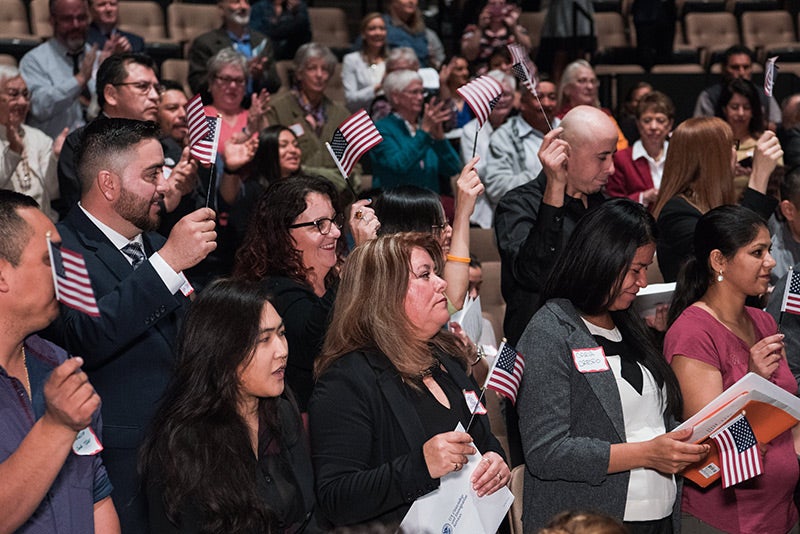
For over a decade, the Community Strategies Group (CSG) has advanced practices and policies that help hard-working rural families earn more, keep more of what they earn, and grow what they have into assets over time. As more immigrants move to rural America, practitioners need new tools and strategies to learn about their new neighbors – and to help immigrant and refugee families get ahead.
“Hello! Please Come In!” That’s the typical welcome sign as you enter rural communities across the United States. But some rural towns and businesses now add signs that read “¡Bienvenidos!” (Spanish) and “Zoo siab txais tos!” (Hmong), among others. That’s because growing numbers of immigrants and refugees are moving into rural communities — from 2012 to 2014, 31 percent of new rural residents were foreign-born.[1] Rural areas facing population decline due to aging and out-migration are noting this trend — along with its benefits and challenges.
Immigrant families move to rural communities seeking the same qualities and values cherished by long-term residents. They want good and safe schools, opportunities to work, an affordable place to live, and close-knit neighbors. But the “good life” can be out of reach for many immigrants, who live disproportionately poor and isolated in rural places. At the same time, welcoming a host of residents from other cultures who have complex legal, language, and housing circumstances can be challenging — it’s a new situation for most rural leaders.
Fuel for the rural prosperity engine
What many don’t realize is that foreign-born residents can help revitalize and breathe new life into a struggling rural community — as consumers, employees, business owners, taxpayers, students, and concerned residents. For example:
- Immigrant and refugee families increase K-12 enrollment and tax revenue, allowing many struggling schools to remain open[2] .
- Foreign-born families can fill vacant housing as renters and homeowners [3], eliminating blight and increasing property values.
- Immigrants fill available jobs, satisfying some of the unmet employer demand in industries critical to rural economies, like agriculture, construction, and hospitality.
- Immigrant and refugee entrepreneurs often open businesses in underserved retail markets[4]. In rural places, this can help revive Main Street and bring needed goods and services back to the community – along with the tax revenue and economic multiplier factor that comes to communities from “buying local.” [5]
Changing perception is everything — or at least the start of it
Immigrants can contribute to their communities only to the extent that long-established neighbors receive, include and support them. In Fleischmanns, a rural town in upstate New York, misunderstandings about immigrants were common — until residents began engaging with their new neighbors. In Bienvenidos a Fleischmanns, a film about the community, townspeople talk openly about their trepidation at the arrival of their new neighbors. To address the issue, long-time residents started talking to immigrants about where they came from, why they enjoyed living in Fleischmanns, and their aspirations for their families. Through this amiable engagement, locals recognized immigrant families’ diligent work ethic and commitment to community values — and eventually began to abandon their negative assumptions. These conversations also helped them realize the wide diversity of refugees and immigrants – different countries of origin, different languages and religions, with wide-ranging skills and jobs in a various industries and professions.
Happenstance encounters can begin conversations with immigrants, but it is more critical to meet people where they are — physically and figuratively. Local organizations and agencies learn more and make stronger connections when they show up and engage, preferably with someone who is bi-lingual, at events and in places where newcomers congregate, like churches, local parks, restaurants, cultural festivals, and schools.
Getting to “we are one”

(Photo Credit: Napa Valley Community Foundation)
There is room for newcomers to make an even greater impact on rural prosperity when communities unite to bolster immigrant success. One Napa Valley, an exemplary initiative of the Napa Valley Community Foundation (NVCF), showcases how collaborative efforts can help rural immigrants get ahead.
NVCF began their efforts in 2012 by commissioning a non-partisan community demographic and needs assessment to “lay down foundation for fact-based dialogue.” The bottom-line finding: immigrants contributed $1 billion annually to the local economy, 15 percent of its total GDP. Moreover, they produced tax revenue proportionate to their share of the population, and two-thirds of them had lived in the area 10 years or longer. Though only 23 percent of the population, they comprised 33 percent of the workforce and 73 percent of the agricultural workforce — the Valley’s primary economic sector. Obviously, immigrants were critical to the Valley’s current economy and its future. But many were low-income and finding it hard to get ahead, especially in the amenity-rich Napa Valley with its high cost of living.
NVCF also learned that 9,000 of the Valley’s Legal Permanent Residents (LPRs — workers with green cards) were eligible for citizenship. But the percentage of the LPRs who became naturalized citizens over time was significantly lower than the state average. Few comprehensive services were available locally to help people through the complex legal process of becoming a citizen, and no one was promoting it. NVCF also uncovered research that when a person naturalizes, their household income can increase 10 percent or more, their English-language skills improve, they build the confidence that promotes job mobility, their children do better in school and are more likely to go to college, and they are more engaged in civic life.
With this information in hand, NVCF collaborated with local organizations to create a program to improve immigrants’ economic success through naturalization. The resulting One Napa Valley has built a group-processing operation to help more LPRs attain citizenship. It includes outreach to immigrants, legal representation and application assistance, English as a Second Language classes specific to citizenship, and fee waivers when needed. Successfully naturalized citizens and their US-born family members are active in the outreach and volunteer efforts, a critical factor in trust-building and program success.
The year before One Napa Valley launched, the one legal aid agency in the area had processed fewer than five naturalization applications. By comparison, in the nearly four years since, One Napa Valley’s work has resulted in 449 newly naturalized citizens (and counting). More than 220 volunteers have been engaged in the effort, and, in total, 870 immigrant neighbors from 46 countries around the world have filed for citizenship or other immigration assistance.
One Napa Valley is going the extra mile to weave their long-term immigrant neighbors into the fabric of their community, and into U.S. society. After all, what could send a stronger “welcome sign” message than helping new neighbors become citizens?
To learn more, watch a presentation on the Napa Valley story by Terence Mulligan, CEO of the NVCF.
[1] Using one-year estimates from the American Community Survey, between the years 2012 and 2014, US rural areas (Census Bureau definition) experienced a net population increase of 338,000 residents. Over the same period, the rural foreign-born population had a net increase of 104,000 residents — accounting for 31 percent of the total net increase in rural population.
[2] See pages 12-14 in the report “A New Age of Immigrants-Making Immigration Work for Minnesota” for an example specific to Minnesota.
[3] See page 13 of Emergent Transnational Spaces: Meat, Sweat and Global (re)Production in the Heartland for a case example of how immigrants can positively affect a rural housing market.
[4] See pages 17-24 of Welcoming America’s Guide to Immigrant Economic Development.

